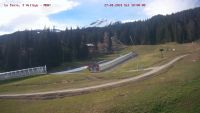The La Tania Ski Blog
Latest news, snow, pics, gossip and information from the locals in La Tania – latania.co.uk
All the latest news from around the 3 Valleys from the La Tania locals. A real blog since 2006, not just endless re-posts for search engine optimisaton! Photos, gossip, snow reports, what's on and all the latest on the Apres Ski scene... Now fully optimised for iPhone, Touch and Android Mobiles - just go to latania.co.uk/blog and view on your phone. Our other past blogs & favourites here
The Hidden Science Behind Winter Sports
The thrill of winter sports often masks the fascinating science that underlies each snow-covered peak, frosty ski run, and breathless uphill climb. The interplay between physics, biology, meteorology, and even psychology creates a tapestry of complexity that can enhance our appreciation of these activities. As we explore this topic, we’ll see that understanding the science of winter sports can be as exciting as speeding down the slopes of La Tania. Just as you might calculate your bet in a strategic game, athletes and enthusiasts alike make decisions based on knowledge, risk assessment, and the variables in play.
Physics of Skiing
Skiing, one of the most popular winter sports, is a prime example of how physics principles dictate performance. When a skier descends a slope, the forces of gravity and friction engage in a constant tug of war. Gravity pulls the skier downhill while friction, mainly in the form of air resistance and the skis’ contact with the snow, works to slow them down. Additionally, the skier’s technique and equipment design can affect these dynamics. For example, a tighter tuck position reduces the skier’s surface area exposed to the wind, decreasing air resistance and allowing for greater speed.
Impact of Altitude on Performance
Altitude presents another interesting facet of winter sports science. At higher elevities, the thinner air can affect athletic performance in several ways. With less oxygen available, athletes may experience reduced aerobic capacity, leading to faster fatigue. However, it’s not all disadvantageous. Thinner air also means less air resistance, which can increase speed in sports like downhill skiing or snowboarding. Adjusting to altitude involves both physiological acclimatization and strategic planning.
Weather Conditions and Snow Quality
The quality of snow, pivotal to the enjoyment and safety of winter sports, is heavily influenced by weather conditions. Temperature and humidity can significantly alter the characteristics of snow. Warmer temperatures often result in wet, heavy snow, making it more difficult for skiers and snowboarders to maintain their speed. Conversely, colder conditions can create lighter, more powdery snow, which many winter sports enthusiasts prefer. Keeping an eye on the forecast allows athletes to anticipate these conditions.
Decision-Making Skills in Winter Sports
Beyond physical factors, psychological elements play a significant role in winter sports. Athletes must make rapid decisions based on their assessment of the environment and their capabilities. This skill requires mental agility and strategic thinking. Whether choosing the best line down a ski slope or deciding when to push harder in a cross-country ski race, athletes constantly analyze and react to their situation.
The science behind winter sports is a realm as thrilling and complex as the sports themselves. Understanding the interplay of physics, altitude, weather conditions, and mental acuity offers a deeper appreciation of these activities. As many other sports, winter sports too involve strategic decision-making based on a host of environmental and physiological factors. With this insight, perhaps your next winter sports adventure will not only be exhilarating but also intellectually stimulating.









































